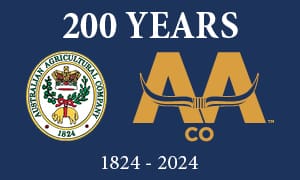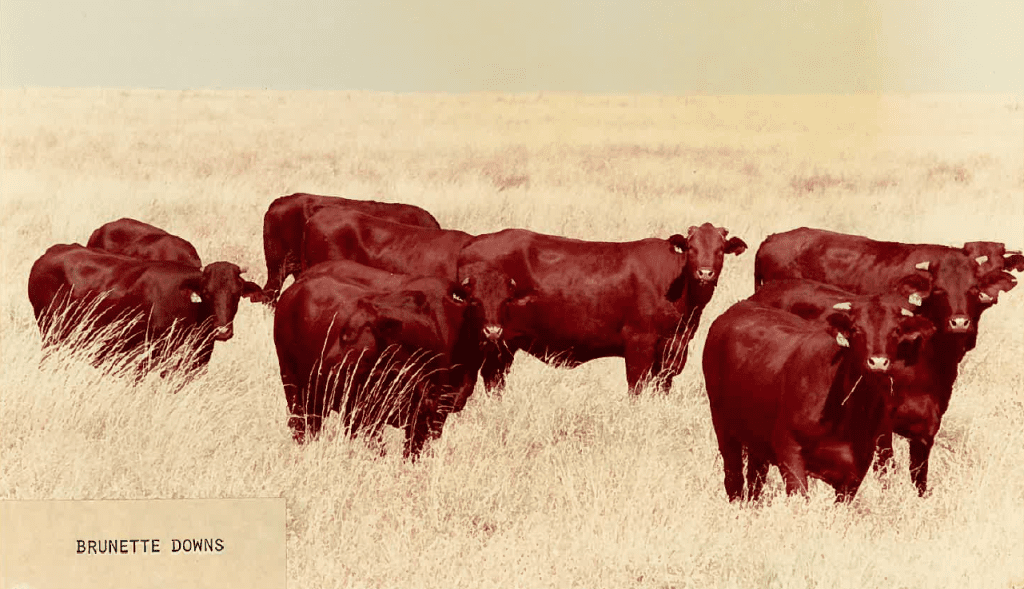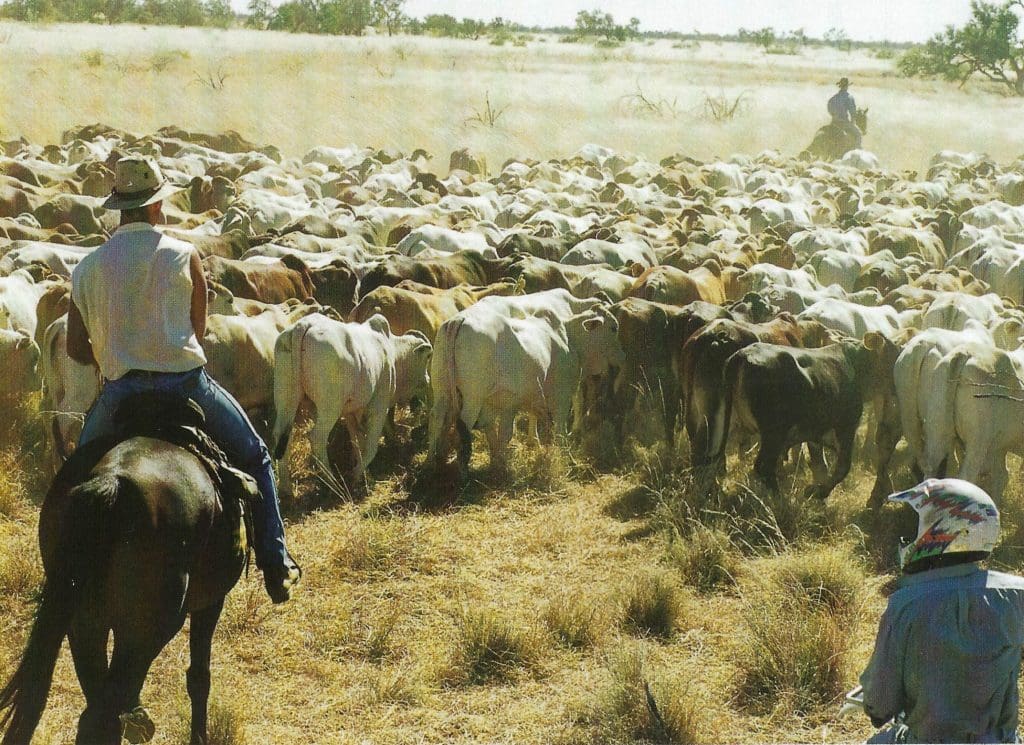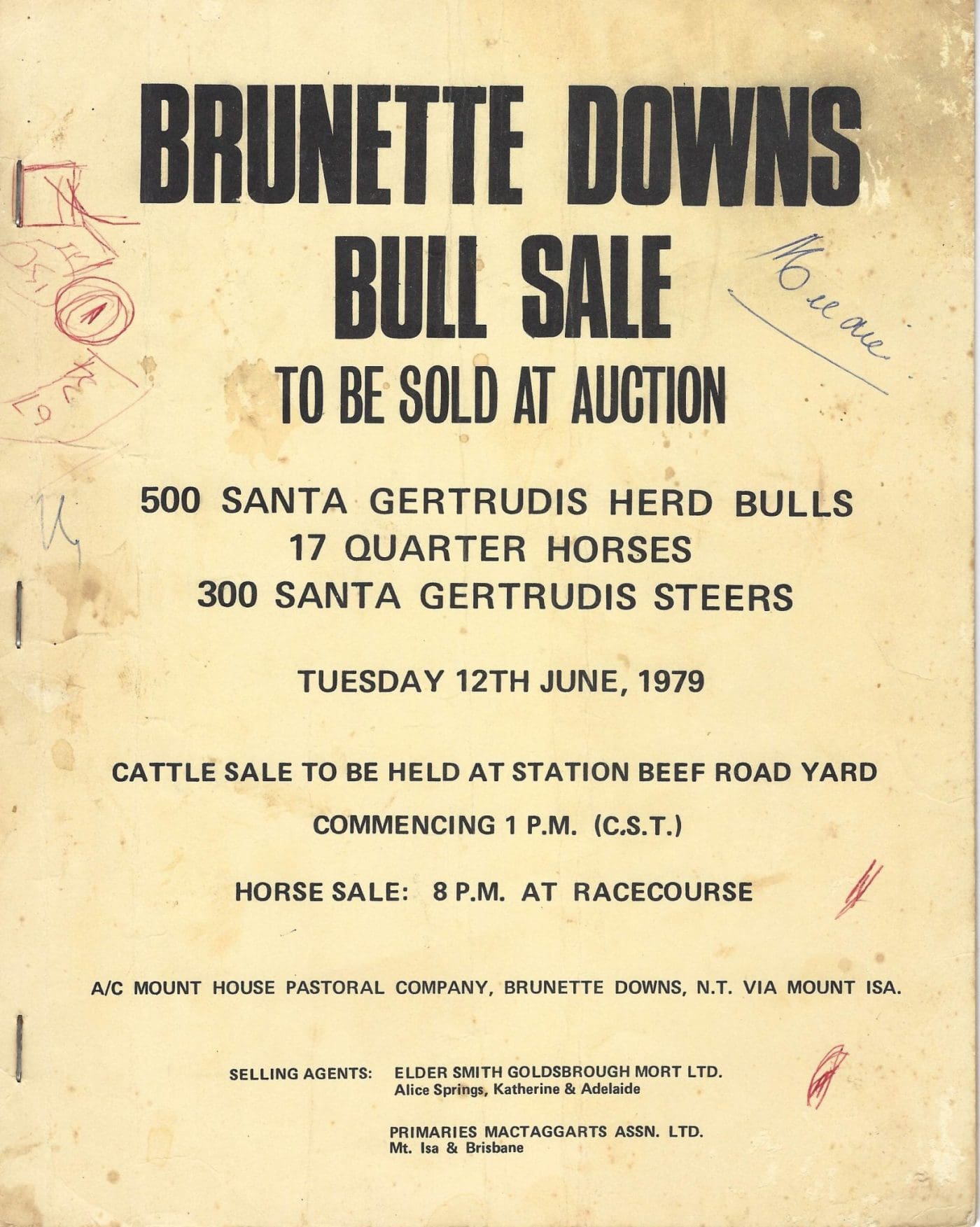 As part of the Australian Agricultural Co’s 200th anniversary this year, Beef Central is publishing a series of articles documenting features of the company’s eventful and often colourful history.
As part of the Australian Agricultural Co’s 200th anniversary this year, Beef Central is publishing a series of articles documenting features of the company’s eventful and often colourful history.
The first of these digs into the history of the world’s largest cattle producer’s beef genetics. In this four part series, we are chronicling AA Co’s progression through its Shorthorn, Santa Gertrudis, Composite and Wagyu eras. Today’s second instalment looks at the Santa era.
FOR more than 30 years, Santa Gertrudis genetics dominated the Australian Agricultural Company’s expanding northern beef breeding herds.
As described in the first item in this series published earlier (click here to view), the company’s foundation was laid using Shorthorn beef genetics. But as AA Co pushed north out of NSW after World War One into ever more hostile northern environments, it became evident that some degree of tropical adaptation was needed, to maximise productivity.

Geoff Wagstaff
According to Geoff Wagstaff, whose 26-year career with AA Co started back in 1979 – this was principally about maximising bullock turnoff weights, rather than fertility or calving percentage.
“The Shorthorns were already very fertile cattle, but the Santa Gertrudis crosses produced considerably heavier carcases, and could handle the conditions better,” Geoff said.
“They could cover the distances better, especially before more bores were put down on the Barkly. Cattle back then had to walk a long way for a drink.”
“I wouldn’t say the Santas got any more calves than the Shorthorns, but it was about weight, on the hooks,” he said.
AA Co already owned and operated Headingly and Avon Downs on the Barkly Tableland since 1916 and 1922 respectively, and Rockhampton Downs since 1948, but it was the company’s purchase of the massive Brunette Downs on the Barkly in 1979 that really drove the push into Santa Gertrudis cattle.
Brunette had already started adopting some Santa genetics, introduced to Australia by previous owner King Ranch Australia in the 1950s, including a registered stud herd (see separate references below).
Geoff Wagstaff was working for King Ranch at the time of Brunette’s sale in 1979, and accepted an offer to join the new owners. He had worked for eight years from 1971 for King Ranch, firstly at its Milton Park Santa Gertrudis Stud at near Bowral in NSW, and later at Mt House and Glenroy in the Kimberley, where some Santa bulls were sent.
In the meantime AA Co had started its own association with Santa Gertrudis cattle when managing director Trevor Schmidt established the Goonoo Goonoo Foundation Stud No 4 near Tamworth. He served for many years as one of the early Santa Society presidents.
Following AA Co’s purchase of Brunette, bulls from the Brunette Santa stud herd regularly found their way onto other northern company properties like Avon, Headingly and Rockhampton Downs, gradually replacing the Shorthorns. In fact smaller numbers of Santa bulls bred at Goonoo Goonoo and Milton Park had been shipped north to company properties from as early as 1956, records show.

Brunette Downs Santa cows, circa 1980s. Picture: SGSBS
It took perhaps seven or eight years after Brunette was purchased in 1979 for the last of the roan Shorthorn cows to leave surrounding AA Co properties like Avon Downs, completing the transformation to cherry-red Santas by around 1985.
“After that, by around 1987, the Barkly herds were nearly all red Santas, as the Shorthorns were bred out, or culled for age,” Geoff Wagstaff recalls.
There was a widely held belief that by way of their Shorthorn origins, the upgraded Santa herds on the Barkly Tableland were superior performers – softer cattle that performed particularly well in the chillers.
“The Shorthorn marbling genetics mixed with the Santas delivered a really good product,” he said.
Geoff was in charge of AA Co’s Barkly Santa bull breeding operations for many years, and later became regional superintendent in change of all the AA Co Barkly properties.
Bull breeding on an epic scale
The sheer scale of purebred Santa bull breeding operations on Brunette is worthy of a story in itself.
In order to remove a lot of unnecessary paperwork (all the bulls were used internally, rather than sold on the open market), the company did away with breed society stud registration, to become a much simpler purebred bull breeding herd.
The Brunette Downs bull breeding herd, alone, numbered 10,000 head of cattle – bigger than many entire Queensland cattle operations, and arguably among the largest bull breeding seedstock programs, and easily the largest Santa example, in the world.
And it faced enormous challenges at the time. Tuberculosis and Brucellosis was still rife across Northern Australia. As a precaution, the bull-breeding herd was insulated from other cattle on Brunette via double perimeter fencing, with a vacant cattle-free zone in between. The bull breeding nucleus effectively operated as a 10,000 head cattle station ‘island’, inside a much larger 80,000 head station (Brunette Downs itself).
The industry-wide Brucellosis and Tuberculosis Eradication Campaign (BTEC) testing and destock program in itself placed additional pressure on bull-breeding activity, as test reactor cattle (both commercial females and bulls) were despatched to abattoirs for slaughter.
The Brunette bull breeding herd included around 3500-4000 cows, plus their calves and weaner bulls.
Some very early attempts at artificial breeding, at-scale, were made, but the AI technology and techniques were still in their infancy, and proved to be less than successful. More success was seen at Meteor Downs, where a dedicated 1000-head artificial breeding centre was built by AA Co in 1994, allowing insemination of cows at scale, with six or eight AI crushes side-by-side. The centre played a more significant role during the later composite breeding era.
With the advent of BreedPlan around 1990, AA Co moved into herd recording in a serious way at Meteor Downs, with particular focus on growth traits.
Brahmans another significant component
While it’s fair to say that AA Co’s ‘trademark’ during this era was its magnificent, large, uniform lines of Santa bullocks, the company also employed large scale Brahman genetics, on harder country.
Rockhampton Downs, bought by AA Co in 1948 and later sold to the Harris family, took limited numbers of Santa bulls from as early as 1956, but the herd gradually evolved into a Brahman/Santa type. and quickly adopted Brahman genetics.

Walking Brahman steers from Gregory Downs to the channels, 1999
AA Co’s harder Gulf properties, plus Wrotham Park near Chillagoe at the base of Cape York Peninsula, bought in 1963, also adopted Brahman genetics, while the larger herds on the softer Barkly Tablelands downs country stayed with Santas (three-eighth Bos Indicus).
Gulf properties like Gregory Downs, Planet Downs, Carandotta, Clonagh, Canobie, Kalmeta, Alcala and Dalgonally were gradually added to the AA Co property portfolio between 1985 and 1990, adding to the demand for Brahman genetics. Much like what had happened at Brunette with Santas, Brahman bull-breeding nucleus herds were established at Canobie and Kalmeta, north of Cloncurry.
New chief executive John Griffith, who joined the company in 1987, encouraged the move into higher content Brahman cattle to handle the tougher Gulf/Peninsula conditions.
External bull purchases
While internal bull breeding within the AA Co network was an enormous undertaking in itself, the company did not go close to meeting its own annual replacement bull requirements.
It was not uncommon for company bull buyers Geoff Wagstaff and Don Wild to buy a couple of hundred bulls each year at the annual four-day Brahman Week Sale in Rockhampton, and large numbers from major Santa and Brahman studs around Queensland.
Some years the purchased bulls, either out of the paddock or through annual sales, numbered 1200 head, Geoff Wagstaff recalls. The best of them were used to top-up the Brunette or Meteor Downs bull breeding nucleus herds, with the remainder going into the commercial breeder paddocks as herd bulls.
Despite its scale, at no stage did AA Co attempt to go down the ‘closed herd’ route, in either its Santa or Brahman bull breeding operations.
Early bull sales
This Brunette Downs 1979 Santa Gertrudis Bull Sale catalogue (click on image to enlarge) provides a graphic snapshot of AA Co’s early excursion into Santa breeding. The company had only recently purchased Brunette Downs, together with Mt House and Glenroy (click here to read earlier Beef Central story on Glenroy’s air-freight beef project) in the Kimberley, from King Ranch.
 “It is the intention of the new owners to maintain the high standard of the Santa Gertrudis Stud operation on Brunette Downs, previously established by the King Ranch Group,” the 1979 sale catalogue said.
“It is the intention of the new owners to maintain the high standard of the Santa Gertrudis Stud operation on Brunette Downs, previously established by the King Ranch Group,” the 1979 sale catalogue said.
The sale offering that year included 500 Santa bulls, ranging from first cross (Santa x Shorthorn) to purebred, plus 17 Quarter Horses and 500 Santa steers. The bulls were sold in K-wagon (rail) sized lots of 20-25 head. Buyers included Russell Pearson from Bull Creek, McKinlay – still a Santa breeder to this day; Austral Downs (then owned by Australasian Grazing), and Hooker Corp (then owner of Victoria River Downs).
Given that this was only a year after the 1974-78 beef slump, prices for bulls looked reasonably solid, ranging from $1500 (bought by Neilsen Grazing) down to $425/head. For comparison, the Santa cross steers 18-24 months in the same sale made from $270 to $340, and the first and second cross Quarter Horses sold to $3500 averaging just over $1000.
Coming up: AA Co’s move into the composite era, and today’s Wagyu era
Previously in this series: Company built on Shorthorn foundation
